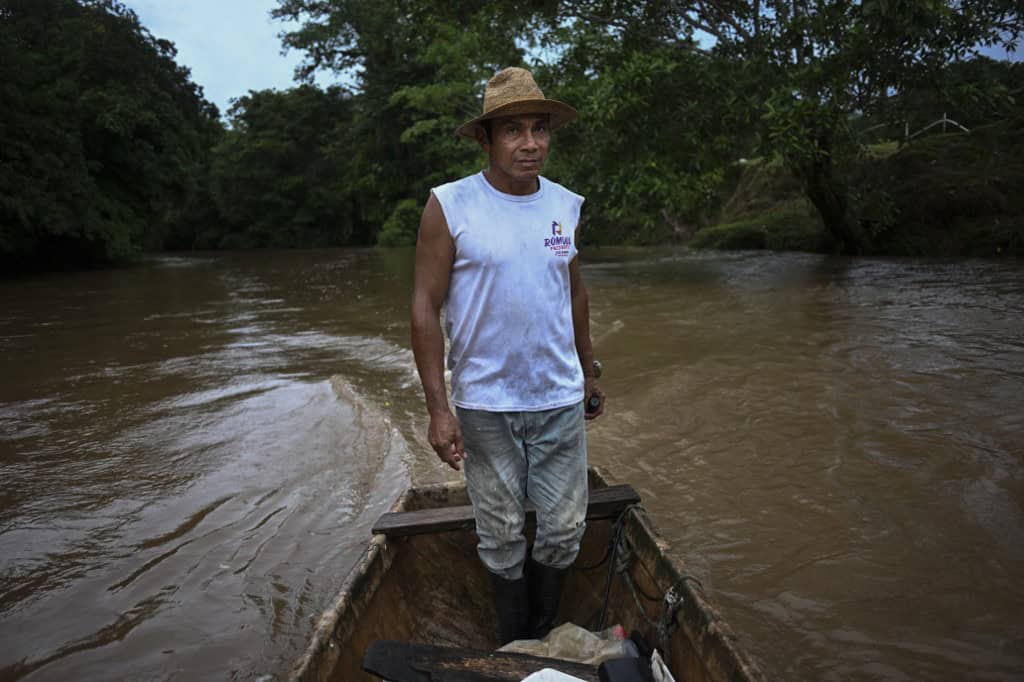Magdalena Martínez has always lived on the banks of the Indio River. But her house will be submerged by a new reservoir for the Panama Canal, and like her neighbors, she plans to resist until the end. The 49-year-old woman shares a simple wooden home with a zinc roof in Boca de Uracillo with her husband and five of her thirteen children. The village is surrounded by green mountains.
Her entire family was born in this small settlement of latrine-equipped homes and around 200 residents, who farm cassava, corn, rice, and bananas and raise animals. Martínez’s house has two rooms and a kitchen with a table, a few plastic utensils, and a couple of pots. There’s no TV, although they can watch YouTube on their cell phones when the signal allows.
But everything could change with the planned infrastructure meant to ensure the continued operation of the Panama Canal, the vital waterway connecting the Caribbean to the Pacific and bisecting the Central American isthmus.“I feel bad about this threat we’re facing,” Martínez she says as she prepares a cup of coffee and heavy rain falls over the village. The community is opposed to their homes being flooded. “We have to fight to the very end,” says Yturbide Sánchez, 44.
Meeting a Need
The Panama Canal Authority (ACP), the autonomous public entity that runs the canal, has decided to build the reservoir to prevent the impacts of severe droughts like the one in 2023, which forced a drastic reduction in ship traffic. Opened more than a century ago, the interoceanic waterway runs on freshwater sourced from rainfall, which used to be abundant in Panama. The same watershed also provides drinking water for half of the country’s population.
The new reservoir will cover 4,600 hectares. Water from there will be transported through a nine-kilometer tunnel to Lake Gatun, which is part of the canal’s watershed. “This project on the Indio River really meets a need that’s been identified for a long time. It’s the water of the future,” Karina Vergara, manager of the Social and Environmental Team for Water Projects at the ACP, she said.
Construction is set to begin in 2027 and be completed by 2032, with an investment of about $1.6 billion. Of that, $400 million is allocated for compensation and relocation of around 2,500 residents from several communities. “We are firmly committed to dialogue and reaching agreements” with affected residents, said Vergara.
Panama’s President, José Raúl Mulino, has voiced his support for the project. The ACP wants to negotiate and reach agreements with local communities, but if the reservoir isn’t built, “we’ll regret it in 15 years,” Vergara said. The 80-kilometer-long canal handles 6% of global maritime trade and is the backbone of Panama’s economy.
Jorge Quijano, a former head of the canal authority, said that without the reservoir, during a dry year the canal “won’t be able” to meet the water demands of both the population and shipping traffic.
Where Are We Supposed to Go?
But the local farmers are reluctant to leave their land. “We feel bad because we don’t know where we’re supposed to go, and they’re not offering anything appealing. We won’t be able to live the same way as we do here,” says Martínez. On Friday, around 400 farmers protested on the Indio River, riding boats and waving Panamanian flags in opposition to the reservoir.
Social organizations also oppose the project. They estimate around 12,000 people will be affected, saying the entire Indio River basin—spanning 58,000 hectares—would be impacted. Some of these groups, including labor unions and anti-reservoir committees, suggest using water from Lake Bayano instead. But the ACP rejects that option, as it is over 100 kilometers away and would require more expensive construction that could impact outlying neighborhoods of the capital.
In the village of Limón, accessible by a 15-minute motorized canoe ride from Boca de Uracillo, residents are also refusing to leave. “We’re not leaving. They’ll have to force us out,” says 25-year-old university student Maricel Sánchez. “None of us have jobs that would allow us to retire, but the land guarantees us a lifelong livelihood. We have everything we need on the land,” says farmer Olegario Cedeño.
And from the house he shares with his wife and three children, surrounded by chickens and parrots, he warns: “We’ll give our lives in this fight.”






